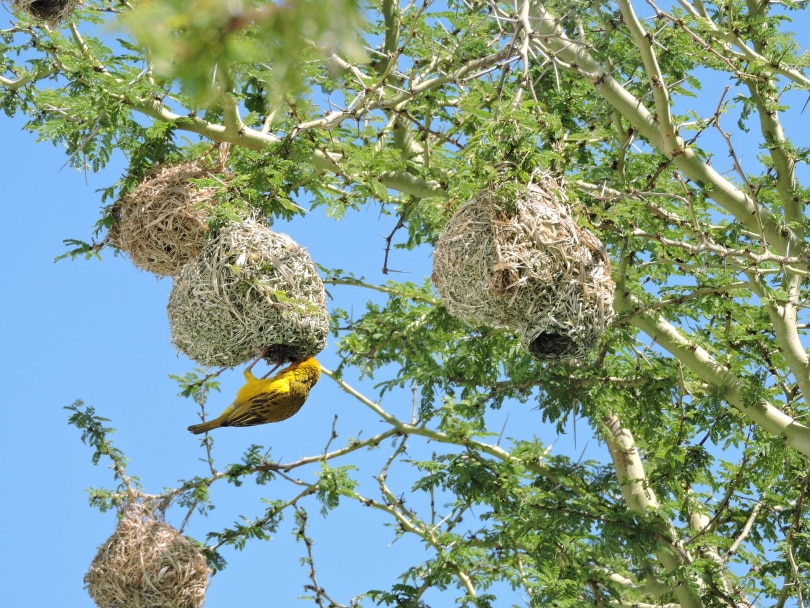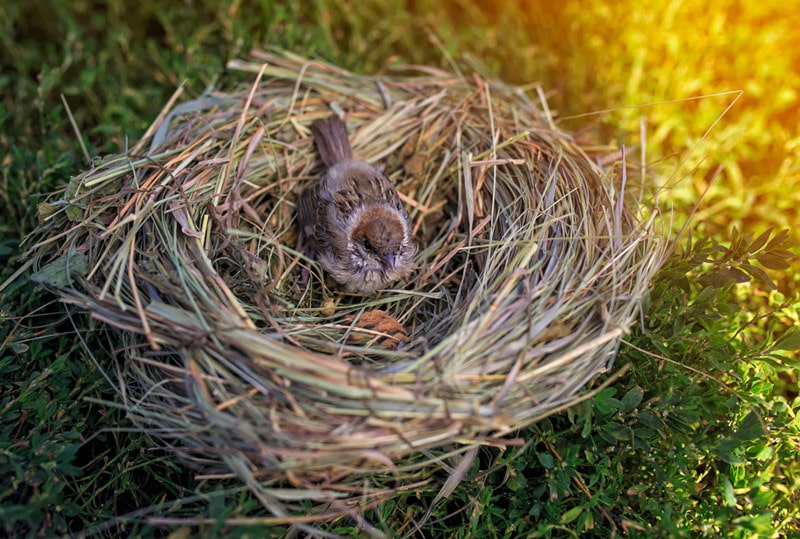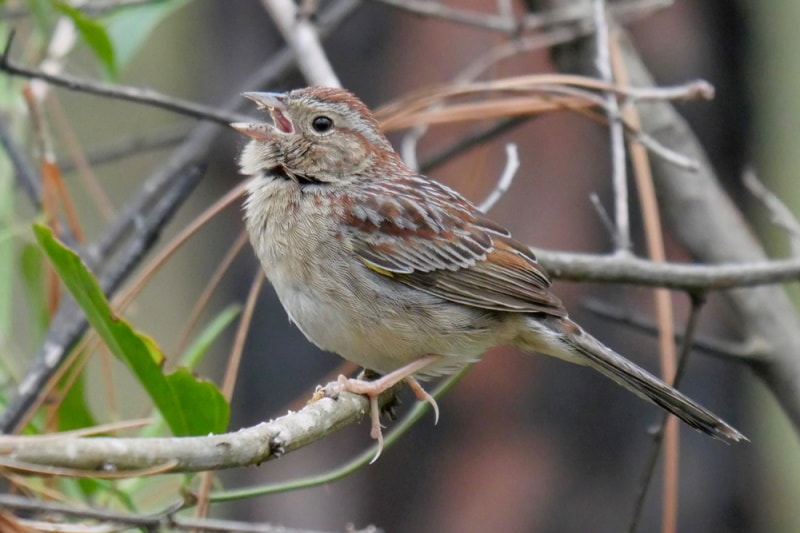Where Do Sparrows Make Their Nests? The Interesting Answer!
Last Updated on

One of the most common birds you’ll see in North America is the sparrow. You will find them in parks, backyards, towns, and, well, pretty much everywhere. Since they’re highly social birds, sparrows love to form massive flocks that, unfortunately, can be a bit of a nuisance. Incredibly, there are over 50 species of sparrows in North America and dozens more in Europe. Although all have their characteristics, the sparrow species share many of the same traits.
One of those traits is where sparrows make their nests, which, like the bird itself, is almost everywhere. You’ll find sparrows under bridges, in barn rafters, on street signs, and especially in birdhouses that are hung in backyards. Don’t have a birdhouse? No problem!
The highly adaptable sparrow will use your house instead, making their nests under awnings, in your chimney, and under the tiles on your roof. Wall crevices and your attic are also very attractive locations for sparrow nests, as well as vents, gutters, and, of course, trees.
Now that you know where sparrows like to make their nests, you’d probably like to learn a few more fascinating facts about the interesting avian species. What does a sparrow nest look like, and when do sparrows lay their eggs? Plus, the age-old question, why are house sparrows bad? We have the answers and several more below!

What Does a Sparrow Nest Look Like?
You’ve probably seen a sparrow nest at least once in your life. They look like a small, round wad of hay or twigs, usually mixed with other material. What kind of material? Plastic, for starters, plus animal hair, feathers, string, and paper, are common building materials.
Some compare the look of a sparrow nest to a small bowl made from dried grass since they are usually a tan, hay-like color. Even if a sparrow uses a birdhouse as their nest location of choice, their nest ends up looking round since they weave it together with all the different materials they use.
Occasionally you’ll find a sparrow nest that doesn’t look like a cup but is instead completely enclosed, with a small opening to get in and out. This type is usually made when it’s not in an enclosed space or cavity. For example, if you find a sparrow nest in a traffic light (which is a favorite spot for them), it will have a “roof” and the aforementioned small opening. However, this nest is seen less frequently since sparrows are cavity nesters.

When Do Sparrows Make Nests and Lay their Eggs?
Sparrows have been known to build nests throughout the year, but in colder climes, they tend to do so from April through August. They usually lay eggs, known as clutches, two or three times a year. However, sparrows have been known to lay four times a year, opportunity and weather permitting.
What’s interesting about sparrows is that they aren’t big defenders of their territory and won’t attack other sparrows that are nearby. They will defend their nest to the death, however. For that reason, you will often find several sparrow nests very close to each other, sometimes less than a foot apart! During their breeding season, female sparrows usually are dominant, while at other times, the males are dominant.
Females usually start laying their eggs within a day after the nest is finished. She will lay one a day until she’s finished. During the breeding season, a female sparrow can start laying a new clutch of eggs within 7 to 10 days after her last chicks have left to live on their own!
They don’t always do this, but they can. Interestingly, the female won’t begin to incubate her eggs until after the last one has been laid. She will stay in the nest with them to roost but won’t incubate until the last egg is in the nest.

Which Sparrow Builds the Nest, the Male or Female?
With most species of birds, the female builds the nest alone, but sparrows are slightly different. That’s because, if unmated, the male sparrow will build the base of a nest and perform a mating ritual to attract a female. That usually involves sitting on the edge of the nest base and calling out until a female becomes interested. When a female comes over, she will inspect the nest base and, if she approves, stay and mate with the male, helping him to finish the nest and build the cup-like interior.
Females don’t always approve, though, leaving the male to continue calling until he finds one that does. In other words, it behooves an unmated male sparrow to build as high-quality and attractive a nest base as possible. Once a male and female have mated, they will use the same nest repeatedly, repairing one from a previous brood when necessary.
How Many Eggs Does a Sparrow Lay?
The average number of eggs laid by a female sparrow is five, but they can lay upwards of eight at one time. Depending on the number of clutches they’ve had, some sparrows will lay fewer eggs also and have been known to lay only one or two.
As you might imagine, sparrow eggs are tiny, usually less than an inch in length and a little over half an inch in width. They are typically an off-white color with a mass of gray or brown spots. Some eggs have a greenish or blueish hue, and egg coloring can vary even in the same clutch.

Which Sparrow Incubates the Eggs, the Male or Female?
Another trait of the sparrow is that both the female and male of the species help incubate their eggs. When the eggs are laid, the female usually spends much more time than the male incubating them while he goes out to find food for both.
However, as the eggs get closer to hatching, they share the incubation duties about 50/50. This period lasts for about 11 days, give or take a day. In colder climates at higher altitudes, though, incubation can take 14 or 15 days.
What Do Baby Sparrows Eat?
Sparrow parents feed their chicks various foods based on their location, the time of year, and the climate. During the warmer months, when insects are abundant, sparrow chicks are fed several types of invertebrates, like caterpillars, grasshoppers, beetles, and other bugs. When the weather is colder, the parents will collect seeds for them.
Since sparrows live very close to humans, they’ve adopted a devil-may-care attitude towards food and will feed their chicks whatever they can find. That includes birdseed from bird feeders and human food like bread, French fries, and vegetable matter that’s been thrown in the trash. The parents swallow the food and, when they get back to the nest, regurgitate it for their nestlings.

If You Touch a Baby Sparrow, Will Its Parents Abandon It?
You may have heard that if you touch a baby sparrow that’s fallen out of its nest, its parents will abandon it. However, this is purely an urban myth. If you see a sparrow on the ground, it might be there because it’s learning to fly. The giveaway is if it has feathers or not. A baby sparrow with no feathers should be placed back in its nest (if you can find it). An older, adolescent sparrow with wings should be left alone as it’s likely on the ground because it’s learning how to fly.
Are Sparrows a Good Bird To Have Around your Yard? (Hint: Not really.)
Even those who love birds aren’t big sparrow fans, mostly due to their very aggressive and boisterous nature. For example, they will often kick other birds out of a birdhouse, even killing the female in the process. They eat everything they can get their beaks on and breed rapidly since they lay 3 or 4 clutches a season. They are also noisy, especially when they gather in massive flocks. In short, while they may be tiny, sparrows are a big nuisance and a threat to other native birds.
Summing Up
Sparrows live all over North America and have adapted well to the continent. They make their nests practically anywhere but tend to make them in a cavity. Since they have no problem with humans, you’ll often find sparrows nesting in your home’s cracks, crevices, and creases. The biggest question you need to answer is this; do you want them there? When you consider how aggressive, loud, and gluttonous they are, chances are you might not.
See also:
Featured Image Credit: Holly Jade, Pixabay
Table of Contents
- What Does a Sparrow Nest Look Like?
- When Do Sparrows Make Nests and Lay their Eggs?
- Which Sparrow Builds the Nest, the Male or Female?
- How Many Eggs Does a Sparrow Lay?
- Which Sparrow Incubates the Eggs, the Male or Female?
- What Do Baby Sparrows Eat?
- If You Touch a Baby Sparrow, Will Its Parents Abandon It?
- Are Sparrows a Good Bird To Have Around your Yard? (Hint: Not really.)
- Summing Up
About the Author Greg Iacono
Greg Iacono is a self-taught writer and former chiropractor who, ironically, retired early due to back problems. He now spends his time writing scintillating content on a wide variety of subjects. Greg is also a well-known video script writer known for his ability to take a complex subject and make it accessible for the layperson.
Related Articles:
10 Types of Hummingbirds in Arkansas (With Pictures)
8 Types of Hummingbirds in Nebraska (With Pictures)
5 Types of Hummingbirds in Idaho (With Pictures)
3 Types of Hummingbirds in Mississippi (With Pictures)
8 Types of Hummingbirds in Kansas (With Pictures)
5 Types of Hummingbirds in West Virginia (With Pictures)
5 Types of Hummingbirds in Ohio (With Pictures)
Where Do Nuthatches Nest? Nuthatch Nesting Habits Explained
